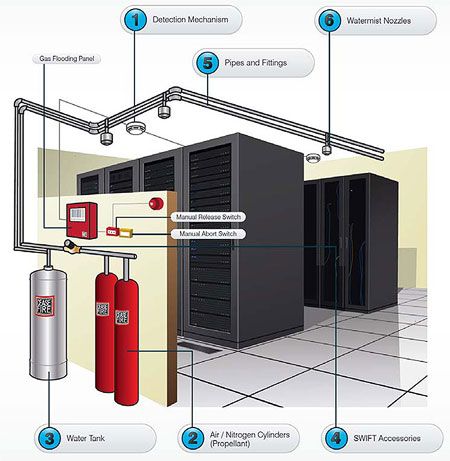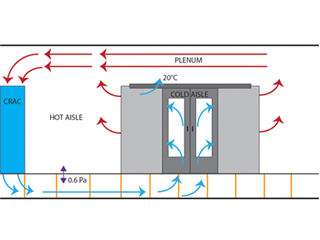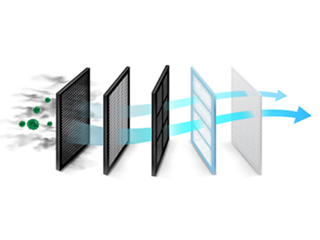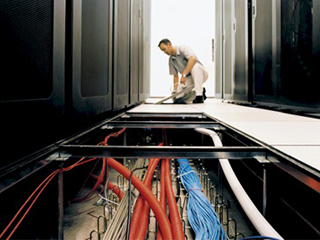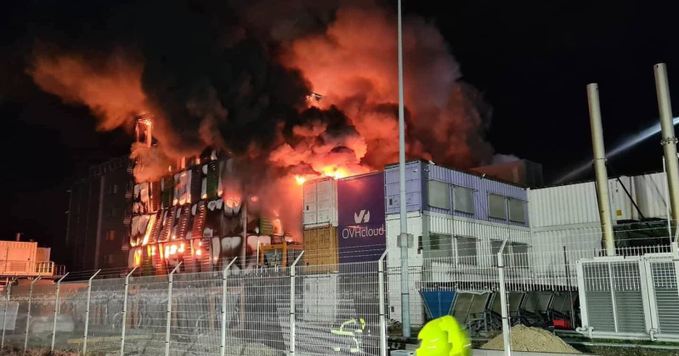
Photo Credit: firepass.com
3-Level Data Center Fire Protection
It is given that the data center is prone to fire hazards. An operating data center is full of electrical components, wires, and cables that have to be maintained all the time. With the backup power supplies and generators around, no doubt that a single data center houses a lot of potential causes of fire.
A data center certainly requires unique fire detection solutions. If a data center is housing thousands of servers, would you not like to detect fire at the earliest possible time? In looking for a data center fire detection solution, it’s essential to evaluate the data center. First, the needs to meet, the layout of the data center, and the most suitable system that can support this type of data center?
The Uptime Institute developed a four-tiered classification system for data center reliability in 1995. The Tier level of a data center will be determined through its Power, Cooling, Monitoring, security, and Serviceability. A data center administration must know how much downtime it can handle to identify its tier level. Tier level 4 is the highest level, with a downtime tolerance of 26.3 minutes a year. This level of data center only has emergency power off and fire as points of failure.
Fire Protection
Fire is the only point-of-failure for every tier level. This is every data center’s nightmare; hence fire protection will be the focus of this article.
Fire can occur in every piece of equipment within the data center, from wires, cables, HVAC, under the raised floors, up in the suspended ceilings, or any combustible item. So fire protection in the data center developed into three different levels.
-
Building Level
This is generally meant to protect the building and all employees within. This is always the first level of fire protection, not just with data center buildings but in general. Usually, fire sprinklers and fire extinguishers for every 3,000 sq feet are required for this type of fire protection. Firewalls are also passive protection that helps delay the spread of fire into other parts of the building.
-
Room Level Fire Protection

Photo Credit: www.Pinterest.ph
Data centers have to implement NFPA 75 – Standard for the Fire Protection of Information Technology Equipment or, in some cases, NFPA 76 – Standard for the Fire Protection of Telecommunications Facilities t to pass NFPA 75 is the minimum standard for the data center to pass and avoid penalties. The standard also requires fire sprinkler systems, either wet-pipe sprinklers or pre-action sprinklers. However, between the two, a pre-action sprinkler is the most common in data centers. Though, as mentioned, the needs and considerations of the data center must be evaluated to know what suits best. Just a little precaution, water sprinklers might be the cheapest fire protection you can get, but water can cause damages to servers and hard drives. Hence, some data centers prefer gas systems.
This gaseous system usually uses clean agent gas or inert gas mixture. This mixture is composed of argon and nitrogen gases meant to decrease oxygen levels in the room to put out the fire. But as effective as it may, inert gas has a large footprint due to the number of gas cylinders used to saturate the area effectively. Inert gas also produces a powerful sound once it is activated. Due to this, it will need additional nozzles to muffle the sounds and not damage the hard drives which are sensitive to at least 130decibels.
Data centers commonly used clean agent gas from Novec 1230 and FM-200. Clean gas can suppress fire by absorbing its heat. These gases are completely eco-friendly and have no ozone depletion. These gases also have smaller footprints as they don’t require as large as the inert gas cylinders. What makes clean agent gases ideal for a data center is that its electrically non-conductive, non-corrosive, and leave no residue upon evaporation. Like other systems, this one also has fire sprinklers and piping systems that activate once the fire detection system sends and alerts.
-
Rack Level Fire Protection
Last but not least fire protection system in data centers is at the rack level. If the first two levels are made to protect the building and rooms, this one is specifically for equipment, which has a value of 57% of the entire cost within a data center. Of course, this big of investments has to be protected 24/7. A reliable fire detection system protects the equipment by detecting fire in its earliest stage. It will alert operators via SMS, email and alarms the suppression system to activate. Detecting fire in early-stage also prevents the damages caused by water-sprinkler and discharge from flood cylinders which also costs a fortune to refill.
Fire Detection System
Datacenter fire detection solutions must be properly designed and selected with a notification system. It’s the most important component of fire protection. Aspects to consider when evaluating fire detection options include early initiation and response and the interface with other systems such as suppression, ventilation shutdown, and early operator warning.
Detection strategies typically include spot-type smoke detectors, air-aspirating smoke detectors, or a combination thereof. As with any approach, there are advantages and disadvantages to these strategies. The data center design and stakeholder

Photo credit: .mynetworkinsights.com
goals help to guide the detection design.
Spot-type smoke detectors are the most common type of smoke detection strategy used in data centers. These detectors are cheap and easy to install throughout the facility. There are two primary forms of spot-type smoke detection: ionization-based detectors and photoelectric smoke detectors. Newer types of intelligent, spot-type detection technologies use built-in algorithms with multiple sensors and multi-criteria. This is to adapt to their environment and minimize the likelihood of false alarms. These detectors often rely upon multiple analog sensors to processed through proprietary algorithms. In many instances, intelligent multi-criteria detectors can respond faster than traditional type detectors while reducing false alarms. Due to their resistance to false alarms, intelligent multi-criteria detectors are becoming more and more popular in data center applications.
Cross-zoned smoke detection is typically the preferred strategy when utilizing spot-type detectors in data centers. This design relies upon the activation of two alarms before subsequent action, such as opening a pre-action valve or cleaning agent discharge. A cross-zoned strategy minimizes the potential for an unwarranted discharge of a fire suppression system. The initial detector can provide a warning to operators and staff within the data center. The need for two separate detectors to activate, however, results in activation delay. This delay may compromise property protection and business continuity goals.
Air-aspirating or air-sampling detection is becoming increasingly popular in data center applications. This is known for its ability to detect a fire in its incipient stages and provides an earlier warning. Like intelligent spot-type detectors, air-aspirating detection can detect a fire at differing smoke obscuration thresholds and, therefore, provide multiple warning levels. For example, a very low obscuration threshold can be programmed to activate a pre-alarm signal, alerting staff to investigate and take action if needed. If a higher obscuration is subsequently detected, suppression systems can be set to discharge.
Many data centers employ a pressurized raised floor to provide cold air to IT equipment and an above-ceiling area as a hot air return. Codes require detectors under the floor or above the ceiling where HVAC piping, electrical feeders, or IT cables are placed within these plenum spaces. Due to the potential for fires to originate within these spaces, detection is usually warranted within these areas.
Fire Detection with AKCP
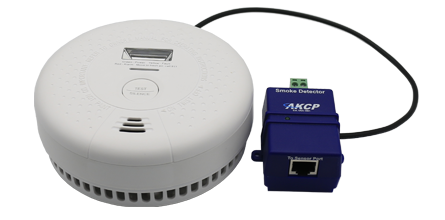
AKCP Smoke Detector
Protect your facilities and infrastructure from fire with the AKCP Smoke Detector. Fire alarm systems need to be monitored. Monitoring alerts authorities of potential deadly fires and alerts operators during the early incipient stage of a fire. For very small fires, such as an overheated wire, operators can quickly locate the incident and take action. Early intervention can significantly reduce the impact of the incident and may help eliminate downtime, depending on equipment redundancy.
Connect the sensor to any AKCP base unit, either to an intelligent sensor port or dry contact connection, and it forms a network-based smoke detection and warning system. Monitor all your smoke detectors from a single user interface, with mapping features of AKCPro Server; you can see which alarm is critical at a glance. Connect the sensor to both your fire alarm panel and the AKCP base unit by using the dry contact connection for your alarm panel and the intelligent sensor port connection simultaneously
In Conclusion
Datacenter houses invaluable data for businesses. Providing optimal protection for this facility must be rendered and implemented. Should three-level protection assure us that a fire won’t get into the data center? No.
A reliable fire detection system is a must and not just an option. Having this kind of system assures us that even a small fire will not damage the facility and equipment. It also helps us optimize the use of three-level fire protection.
Reference Links:
https://www.akcp.com/akcp-products/smoke-detector/
https://www.downloads.siemens.com/download-center/Download.aspx?pos=download&fct=getasset&id1=A6V10859638
https://www.firetrace.com/fire-protection-blog/three-levels-of-data-center-fire-protection
https://www.orrprotection.com/applications/data-centers

